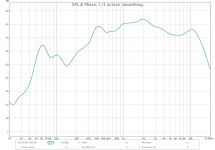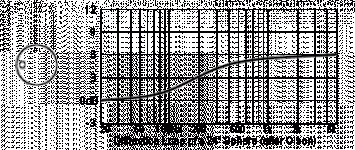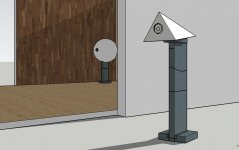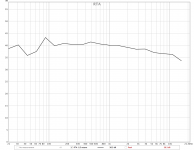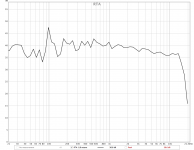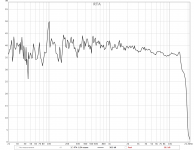But these calculations are only valid for a flat front panel only.
I'm not sure about cut-off frequency behavior but let's imagine a wave with signfically higher frequency.
In this case we have 100% support near the speaker that seamlessly fading to zero on the half-globe boundry. The side parts will reflect the wave at 90% angle so it will not reach the listener directly without reflections and delays.
I'm not sure about cut-off frequency behavior but let's imagine a wave with signfically higher frequency.
In this case we have 100% support near the speaker that seamlessly fading to zero on the half-globe boundry. The side parts will reflect the wave at 90% angle so it will not reach the listener directly without reflections and delays.
Neat project. I bet the imaging and soundstage is unparalleled. The baffle is perfect and there should be no diffraction issues. I don’t think the diameter needs to be so big. I think about 20cm diameter would be fine - you are not looking for it to make any bass, mount it above a woofer (in a rectangular box even with deep round overs) for bass and XO circa 600Hz to 900Hz for a FAST.
So for 300 Hz half a wave lenght is a 0.57 m.
And a whole circumference of a ball should be 0.57 * 4 = 2.29 m
2 pi r = 2.29 m
r ~= 0.36 m, d ~= 0.73 m
Right?
Hmm, that sounds large - maybe I'm in error about the calc... sorry!
//
"Olson has carefully documented the diffraction loss of enclosures of various shapes (see references below). All enclosure shapes exhibit a basic 6 dB transition (or "step") in the response with the bass ending up 6 dB below the treble. A spherical enclosure exhibits this transition clearly with a very smooth diffraction loss curve."
And it doesn't match what I've calculated above.
"Assuming that the 3 dB frequency is inversely proportional to the baffle diameter I have arrived at the following approximation for calculating the -3dB frequency as a function of baffle diameter.
f(3) = 115/W(B)
(where W(B) is the baffle width in meters)"
True Audio TechTopics: Diffraction Loss
Hm, I don't like "approximation" approach because we have all the data we may need for the calculations.
Here is an original Olson's article
https://www.aes.org/tmpFiles/elib/20200927/17816.pdf
And it doesn't match what I've calculated above.
"Assuming that the 3 dB frequency is inversely proportional to the baffle diameter I have arrived at the following approximation for calculating the -3dB frequency as a function of baffle diameter.
f(3) = 115/W(B)
(where W(B) is the baffle width in meters)"
True Audio TechTopics: Diffraction Loss
Hm, I don't like "approximation" approach because we have all the data we may need for the calculations.
Here is an original Olson's article
https://www.aes.org/tmpFiles/elib/20200927/17816.pdf
Attachments
Last edited:
I think why its not straight migth be due to the pipe. Thats why I want to try a triangular closed cavity also
With the globes as baffles of course!!
//
With the globes as baffles of course!!
//
Attachments
Last edited:
Make a 5-sided pyramid Dagger rear chamber and hide that inside the sphere. 5 sides is good like 3 as it doesn't support parallel wall resonant modes but gives you a rounder mouth to work with. It woulld seem that a couple of large wooden salad bowls from Ikea would be ideal. Blanda is 11in dia (280mm) and $18 ea x 2 is $36 - a very reasonable price. Just cut hole and rebate it and install 5 sided Dagger inside.
BLANDA MATT Serving bowl, bamboo, Height: 5" Diameter: 11" - IKEA
This looks idea for a 600Hz XO:
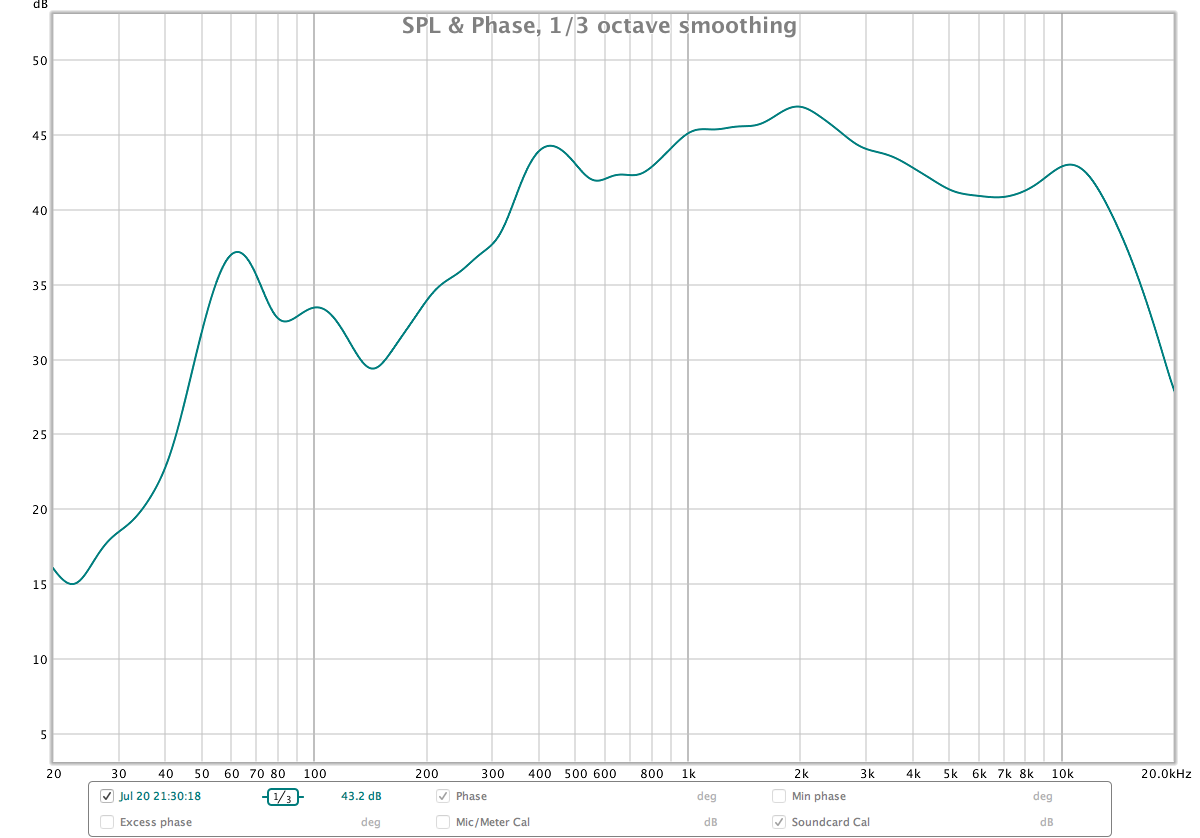
BLANDA MATT Serving bowl, bamboo, Height: 5" Diameter: 11" - IKEA
This looks idea for a 600Hz XO:
"Olson has carefully documented the diffraction loss of enclosures of various shapes (see references below). All enclosure shapes exhibit a basic 6 dB transition (or "step") in the response with the bass ending up 6 dB below the treble. A spherical enclosure exhibits this transition clearly with a very smooth diffraction loss curve."
And it doesn't match what I've calculated above.
"Assuming that the 3 dB frequency is inversely proportional to the baffle diameter I have arrived at the following approximation for calculating the -3dB frequency as a function of baffle diameter.
f(3) = 115/W(B)
(where W(B) is the baffle width in meters)"
True Audio TechTopics: Diffraction Loss
Hm, I don't like "approximation" approach because we have all the data we may need for the calculations.
Here is an original Olson's article
404 Not Found
I suspect that the prediction based on f(3) = 115/W(B) does not match the measured response in this case is because the tiny 3" driver is already running out of steam when it gets to 300Hz and below. In other words, the 3" driver itself is not giving a flat response in the range where the 2Pi-to-4Pi transition takes place.
We can take a look at the response of 3FE22 measured by Faital Pro:
https://www.parts-express.com/pedocs/specs/294-1100-faitalpro-3fe22-4-specifications.pdf
The measured curve shows a 10dB drop from 500Hz to 100Hz. I did not see in the spec sheet how Faital Pro did the measurement, but I suspect that it was done with the driver on an IEC baffle.
It is not clear to me what kind loading on the 3Fe22 is given by the back horn (or tapered tube) used by TNT, but I doubt that it would boost the bass frequency response of the 3Fe22 much beyond what's shown in the spec sheet. Also, even if the 3Fe22 is put in a sealed box with Qtc of 0.707, the f3 (according to PartsExpress) is 244, which means the 3Fe22 is not going to be flat at around 172Hz, where the predicted F3 of 2Pi-to-4Pi transition is.
So, perhaps the response measured by TNT is not drastically different from what we should expect by combining the f-response curve from the spec sheet with the 6-dB transition curve for a 24"-D sphere. Maybe like XRK said, a smaller sphere (and a higher XO frequency) would suffice for 3Fe22, as the small driver cannot take advantage of the lower 2Pi-to-4Pi transition range offered by the large sphere.
Kurt
Last edited:
I will add again that these where measurements at listening position (3m). I'll get back with 50cm distance measurements - i have been meaning to do these for distorsion....
//
//
Following up on my earlier post, I am fairly intrigued by the manufacturer's frequency response of the 3FE22, because I don't recall seeing published response curves of other 3" fullrangers with such a 10dB decline from 500Hz to 100Hz. To confirm my impression, I checked the spec sheets of 3 other fullrangers of 3 different brands, and none of them shows such a decline.
Dayton PC83-8:
https://www.parts-express.com/pedocs/specs/295-156--dayton-audio-pc83-8-specifications.pdf
Fountek FR99EX:
https://www.parts-express.com/pedocs/specs/296-719-fountek-fr88ex-specifications.PDF
Tangband W3-1878
https://www.parts-express.com/pedocs/specs/264-902--tang-band-w3-1878-spec-sheet.pdf
Hi TNT, I am looking forward to seeing your "nearer field" measurement of the 3FE22 in your gypsum sphere. Just a few days ago I was thinking about trying the Fountek FR88EX drivers I have in the paper mache spheres I made, but I was not sure whether FR88EX in a sealed box within a sphere could give useful mid-bass response down to 200Hz, where a bass module will take over.
By the way, I didn't think of using gypsum pads to make a sphere, and it seems to be a great idea. Maybe I'll give it a try if I want to make a couple larger spheres.
Kurt
Dayton PC83-8:
https://www.parts-express.com/pedocs/specs/295-156--dayton-audio-pc83-8-specifications.pdf
Fountek FR99EX:
https://www.parts-express.com/pedocs/specs/296-719-fountek-fr88ex-specifications.PDF
Tangband W3-1878
https://www.parts-express.com/pedocs/specs/264-902--tang-band-w3-1878-spec-sheet.pdf
Hi TNT, I am looking forward to seeing your "nearer field" measurement of the 3FE22 in your gypsum sphere. Just a few days ago I was thinking about trying the Fountek FR88EX drivers I have in the paper mache spheres I made, but I was not sure whether FR88EX in a sealed box within a sphere could give useful mid-bass response down to 200Hz, where a bass module will take over.
By the way, I didn't think of using gypsum pads to make a sphere, and it seems to be a great idea. Maybe I'll give it a try if I want to make a couple larger spheres.
Kurt
Exactly these!
Had a very nice session today with my globes. They can do a thing or 2.
I'm still collecting energy and inspiration to do the measurements 🙂
//
Had a very nice session today with my globes. They can do a thing or 2.
I'm still collecting energy and inspiration to do the measurements 🙂
//
Finally gave my globes some new clothes...
- 200 Hz XO to low -> now 300 12/oct
- Sorted out the bass from the corner lines - behaving the best ever - but still that pesty 100 - not much to do as it is floor/ceiling.
- Tweaked the globes to tighter FR deviations. see 1/2 oct, 1/6 oct and 1/24... this is in listening chair. Pink noise and circling mic in ear hight.. scarts form one and the same measurement, just different smoothing.
Distorsion is coming....
Just now playing Chopin / Zimmerman... it's so great... and delicate and powerful.... these are special.
//
- 200 Hz XO to low -> now 300 12/oct
- Sorted out the bass from the corner lines - behaving the best ever - but still that pesty 100 - not much to do as it is floor/ceiling.
- Tweaked the globes to tighter FR deviations. see 1/2 oct, 1/6 oct and 1/24... this is in listening chair. Pink noise and circling mic in ear hight.. scarts form one and the same measurement, just different smoothing.
Distorsion is coming....
Just now playing Chopin / Zimmerman... it's so great... and delicate and powerful.... these are special.
//
Attachments
Last edited:
Exactly these!
Had a very nice session today with my globes. They can do a thing or 2.
Nearly choked on my tea reading that!
Quite the intriguing build...Searching parameters for a more substantial FR driver for such an enclosure, & the benefits it provides, I found such that just might work.
The Visaton B-200 eight-inch FR driver comes in at an f3 of 20 hertz in a BR alignment with a volume of a sphere of around 0.88 meters in diameter...???
-----------------------------------------------------------------------Rick....
The Visaton B-200 eight-inch FR driver comes in at an f3 of 20 hertz in a BR alignment with a volume of a sphere of around 0.88 meters in diameter...???
-----------------------------------------------------------------------Rick....
Reversed exponential horn:
https://www.google.com/url?sa=t&rct...S2293181.pdf&usg=AOvVaw3Djy_dSVz2NCDDgjN2Ff3t
EPO - European publication server
NB that the sphere is not a pressure chamber - the driver backside see no sphere - it only works as a baffle and impedance transformer. It stops working as such at as described in post #25 & #27.
The reversed horn is of course not used to amplify anything but hopefully to make for a black/infinite cavity for the driver to play into without any reflexions. I suspect it dosnt work fully out as my upcoming measurements will probably show - maybe event later today - I feel engaged.
//
https://www.google.com/url?sa=t&rct...S2293181.pdf&usg=AOvVaw3Djy_dSVz2NCDDgjN2Ff3t
EPO - European publication server
NB that the sphere is not a pressure chamber - the driver backside see no sphere - it only works as a baffle and impedance transformer. It stops working as such at as described in post #25 & #27.
The reversed horn is of course not used to amplify anything but hopefully to make for a black/infinite cavity for the driver to play into without any reflexions. I suspect it dosnt work fully out as my upcoming measurements will probably show - maybe event later today - I feel engaged.
//
Last edited:
- Home
- Loudspeakers
- Full Range
- Wideband globes
